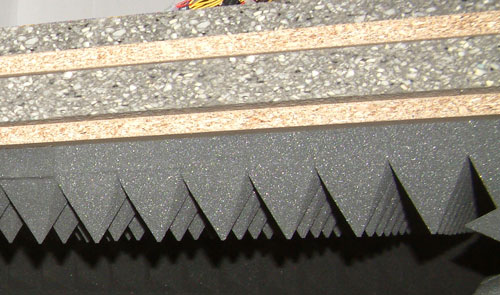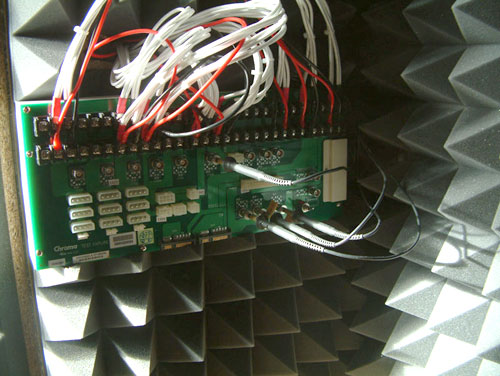Corsair TX750W Power Supply
by Christoph Katzer on October 30, 2008 3:00 AM EST- Posted in
- Cases/Cooling/PSUs
Testing with the Chroma ATE Programmable Load

Our test equipment consists of two Chroma programmable DC Loads that enable us to test power supplies with an output of up to 1500W. The biggest advantage of the Chroma DC Loads is simply the high precision it provides. It can measure differences as small as 0.001V and 0.0001A, which will provide us with best-in-class results.
When programming the Chroma with specific amounts of load calculated according to the ATX norm, we are able to load power supplies to an exact percentage. We can now show results at every specific percentage needed. To get the best overview of a power supply, we load each unit with 10%, 20%, 50%, 80%, 100%, and 110% of the specified output. This is easy to calculate for a 1000W power supply: the 10% load is 100W and 110% load is 1100W. Remember that this is the amount of power the PSU delivers; due to inefficiencies, a power supply will actually draw more power from the wall.
Note: If you would like to know more about our testing methodology, equipment, and environment, please read our PSU testing overview.
We have added an additional 10% on the highest load to see how the units perform with overload. This test will be performed in all future reviews. The overload test is performed at room temperature as well as under more stressful conditions; to ensure we are not too cruel to the power supplies, we will keep the ambient temperature at 50°C in the stress test. Experience shows that many units can stand the overload at room temperature but will experience problems with higher temperature and overload together. Only the best-built units will survive this.

The Testing Environment
There is one flaw in testing power supplies with programmable loads while trying to measure the sound pressure levels at the same time. Because the programmable loads get very loud, there is no chance of hearing the power supply on the test stand. In order to make accurate measurements of the noise levels we needed a way to separate the test unit and the programmable loads. Our solution was to build a very thick box around the unit.

We concluded that a five-layer box with a total thickness of 6" (15cm) containing two layers of wood and three layers of special foam would suffice. It is designed as a box within a box. The inner box does not touch any part of the outer box, making it difficult for acoustic noise to pass through in the form of vibration. Each box is isolated on both sides with a layer of heavy foam that is normally used to insulate engines. On the inside we have an additional layer of 4" (10cm) thick pyramidal foam on every side of the box to eliminate the acoustic waves coming from the test object as well as we can.

To ensure a completely closed system we installed the printed circuit board that the connectors of the power supply are attached to inside the anechoic room/box. In other box designs, you would need to put all the cables through the wall. Unfortunately, that would result in the inside of the box not being fully isolated anymore. Our design keeps everything that needs to be connected inside of the box and maintains isolation.










26 Comments
View All Comments
Martimus - Thursday, November 6, 2008 - link
Holy Voltage Ripple Batman!I can't believe that a Corsair PSU is that bad at load. If I were running the test, I would double check to make sure I wasn't loading it improperly, because I wouldn't expect such a poor showing. I kind of hope that it was an error on your part, since I don't know any other manufacturers that make silent PSU's with the quality Corsair usually provides. PCP&C are always rock solid, but they usually are a little loud.
OddJensen - Thursday, November 6, 2008 - link
Well, I'm very happy with my Corsair units, and so are the people which I recommended them to. It's good quality without being extremely pricey. I trust mine as much as any other high quality brand. Haven't gotten a TX750 yet tho, I've mostly gone with the Seasonic sourced ones.billt - Tuesday, November 4, 2008 - link
I have two Corsairs's where OEM is Seasonic; they are great and the reviews reflect that. The non-Seasonic Corsairs are not the same quality, as this review reflectsXiZeL - Friday, October 31, 2008 - link
i dont get why it wont do crossfire...JarredWalton - Sunday, November 2, 2008 - link
It will do CrossFire just fine - it's just not CF certified by AMD/ATI. But then, is that even something that they do? I don't know.Barbarossa - Tuesday, November 4, 2008 - link
Actually the TX750 is certified as well:http://game.amd.com/us-en/crossfirex_components.as...">http://game.amd.com/us-en/crossfirex_components.as...
poohbear - Thursday, October 30, 2008 - link
"We also received an HX520W recently"
recently? This psu was one of corsairs first and its like 2 years old now, how come u're just receiving it now??
Christoph Katzer - Friday, October 31, 2008 - link
I don't know why it's not clear that there are a few PSUs more than just Corsairs. We do our best but can't have all the time the latest stuff from each company. And like in this case if we forget a unit we test it later again after it settled.Amart - Thursday, October 30, 2008 - link
Excellent review, especially considering the price changes on the market. I recently upgraded my PSU and this one was one of the considerations. I went with the PCP&C 610 Silencer, slightly less expensive and I like the Continuous @ 40c guarantee that they offer.By the way, the most recent BFG models in the price range also offer the same "40c" performance guarantee and get excellent reviews.
I don't know why Corsair stopped using that as part of promoting their products.
Barbarossa - Thursday, October 30, 2008 - link
Actually, all the TX750 is Continuous @ 50C.The only PSU we sell that's rated @ 40C is the CX400.